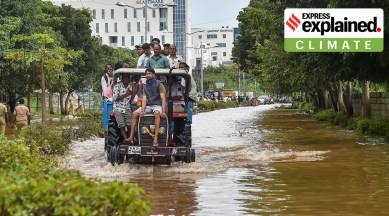Bengaluru floods: How lake catchment alterations upped urban flooding risk in the city
Bengaluru floods: The recent urban flooding is being blamed on the loss of interconnectivity of water bodies, a distinct feature of the city.

The overflowing of Bellandur, Varthur, Saul Kere and Kaikondrahalli lakes in Bengaluru has put the spotlight back on the loss of interconnectivity of water bodies, which is being blamed for the recent urban flooding. While the government took up the desilting work of Bellandur and Varthur lakes in June 2020, that work is yet to be completed.
Loss of interconnectivity between lakes
Dr T V Ramachandra, from the Centre for Ecological Sciences at the Indian Institute of Science (IISc), says that loss of interconnectivity among lakes in the region is the major reason behind the flooding.
In 1800, Bangalore (740 sq km region) had 1,452 water bodies with the water storage capacity of 35 TMC (thousand million cubic feet), which helped in optimally harvesting rainwater and also mitigated flooding.
“Today we have 193 lakes and most of them have lost connectivity due to blocking of rajakaluves (storm water drains) with solid waste or because of encroachment. Lakes and their beds are also being encroached. The silt deposited in the lakes also reduces the water holding capacity of the lakes,” he said.
Catchment alterations
Bengaluru has the distinction of having inter connected lake systems. Valley zones connecting the lakes are to be protected to ensure the continuation of hydrological functions of the drains and flood plains. However, valley zones in the city continue to be abused despite norms to protect these fragile ecosystems.
“Bellandur-Varthur wetland ecosystem has been experiencing threat due to the large scale catchment alterations with changes in the land use, land cover. This wetland is now being converted for mixed land use to build both residential and office complexes. Alterations in the wetland began in 2004 and aggravated post 2008. The alterations of these wetlands were initiated by filling the low lying areas with excavated earth debris, followed by other construction activities. The land fillings have breached both drains and lakes,” Ramachandra said.
The upstream lakes to Bellandur and Varthur, which include Kaikondrahalli and Saul Kere, are also overflowing due to the rampant encroachments of storm water drains.
Ramachandra added that his study found that the storm water drain connecting Bellandur lake from the city market side was narrowed to 28.5 m against the original width of 60 m.
Also, a 2021 audit report by the Comptroller and Auditor General (CAG) said that the stormwater drain department does not maintain records like work registers or the progress reports of works. It also said that BBMP (Bruhat Bengaluru Mahanagara Palike) failed to factor in high intensity rainfall amid rapid urbanisation and did not adhere to the provisions of Indian Road Congress and the guidelines of National Disaster Management Authority while designing and constructing roads/drains. “Ground water recharge structures were not taken up due to flow of sewage in SWDs. Water bodies and drains were not inter-connected and linkage between different drains was absent. This affected free flow of stormwater leading to frequent flooding in various parts of the city,” the report said.
Failure to desilt
Bangalore Development Authority (BDA) in June 2020 had commenced the desilting at Bellandur and Varthur lakes. Officials say that due to the pandemic the work was stopped and was resumed again in January 2021. In April 2021, the work was again discontinued.
Varthur Lake warden Jagadish Reddy said, “The desilting, whatever has happened till now, indeed improved the water retention capacity of Varthur lake. The desilting at Bellandur lake was stopped in March and at Varthur it was stopped in April. The problem is that there are more than 90 lakes in this series of the lakes of which Varthur and Bellandur are part of. Most of these lakes and drains in this series are either encroached or not desilted leading to flooding.”
Bangalore Development Authority officials say that the desilting of these lakes will take another one year. “The desilting at these two lakes was supposed to be completed in August this year. One of the major reasons in the delay of desilting is the identification of the area where the silt has to be deposited….The silt was initially given even to the farmers to be used as manure. Moreover, in this heavy rain it is not possible to carry out desilting,” the official said.
Encroachment problem
There are more than 6,000 illegal layouts across the city. A senior IAS official with the revenue department said that over 22 layouts have been constructed on lake beds across the city. But officials incharge of removing those encroachments say that despite orders to remove them, they face resistance from residents.